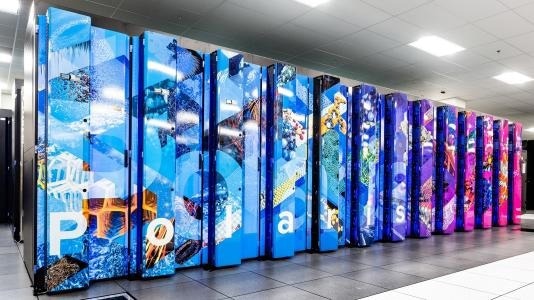Since research and development is a costly endeavor for any business, a lot of companies start with a new patent—a completely original concept that has been thoroughly examined and is prepared for expansion.
 Argonne’s Polaris supercomputer brings advanced capabilities for research involving simulation, AI and data analysis workloads. Image Credit: Argonne National Laboratory.
Argonne’s Polaris supercomputer brings advanced capabilities for research involving simulation, AI and data analysis workloads. Image Credit: Argonne National Laboratory.
It can be challenging for established companies to strike a balance between profit margins and R&D costs. Modern product development requires sophisticated computer modeling, which saves companies millions of dollars by eliminating the need for costly prototypes and testing.
Such modeling, whether for the search for new chemicals or materials or for simulating mechanical engineering issues, is time-intensive and costly, and new products take years to develop from concept to production.
While many of the world’s fastest computers are privately held, constructing such a computing infrastructure is both dangerous and expensive. This is why government support for supercomputing is crucial to the advancement of American commerce.
The High Performance Computing for Energy Innovation (HPC4EI) program of the US Department of Energy (DOE) has announced financing for a new round of business partnerships. Through these initiatives, the private sector will be able to better utilize DOE’s high-performance computing (HPC) facilities to increase industrial efficiency and investigate novel materials for use in clean energy applications.
Four of the projects are receiving assistance from DOE’s Argonne National Laboratory, which also provides access to its supercomputing capabilities and expertise. This includes Argonne’s Laboratory Computing Resource Center and the potent systems at the Argonne Leadership Computing Facility (ALCF), a DOE Office of Science user facility.
Employing cutting-edge computing resources is one advantage, but companies will also gain from collaborating with some of the top HPC specialists globally. Scientists at Argonne are skilled in leveraging supercomputers and collaborating with partners to optimize workloads related to artificial intelligence and high-performance computing for the systems.
This year, Ford Motor Company, Capstone Green Energy, Lakril Technologies Corporation, and Power Systems Manufacturing are partners in Argonne’s HPC4EI initiatives.
The breadth of these awards shows how DOE’s investment in Argonne’s massive HPC resources and deep expertise can help companies large and small improve their products while reducing carbon emissions.
David Martin, Manager, Industry Partnerships and Outreach, Argonne Leadership Computing Facility, US Department of Energy
Helping Ford with Battery Technology
Argonne's Center for Nanoscale Materials, a DOE Office of Science user facility, is led by group leader Subramanian Sankaranarayanan, who oversees the lab’s collaboration with Ford Motor Company’s research to enhance battery manufacturing efficiency.
To build robust long-cycling lithium batteries for electric vehicles, solid-electrolyte interphase (SEI) production is a crucial process that Sankaranarayanan and Ford researchers will model and enhance using high-performance computing (HPC).
Currently, one of the longest processes in the battery production process is the development of the SEI, which can take a week or longer. Researchers can assist battery facilities in drastically lowering energy usage and carbon dioxide (CO2) emissions by hastening the production of SEI.
Power and Heat Generation with Microturbines
Though the C200 microturbine system for power and heat generation from Capstone Green Energy is already environmentally friendly, the company intends to redesign, optimize, and refit the system so that it runs exclusively on hydrogen fuel in collaboration with Argonne research scientist Debolina Dasgupta.
The computational fluid dynamics simulations needed to evaluate and contrast designs in order to generate a configuration that can guarantee the optimum of the engine’s design for combustion and fuel injection systems are one reason why Capstone needs supercomputers. Capstone’s transition to hydrogen fuel will be aided by this new modeling effort, which will lower nitrogen oxide emissions.
Argonne Sketching Out a “Green” Paint
John Low, an Argonne computational scientist, is working with Lakril Technologies to reduce the carbon footprint of the $10 billion paint, coatings, adhesive, and super absorbent polymer (diapers) markets.
They hope to lessen the 16 million kg of CO2 produced yearly to produce the acrylic acid that is normally used to make these products by turning corn and other bio-derived sugar sources into paints and coatings. The team wants to boost a new catalyst’s performance so that it can facilitate the switch to sustainable biomass feedstocks by utilizing Argonne’s HPC facilities.
Reducing Hydrogen Flashback
With the help of cutting-edge technology from Power Systems Manufacturing (PSM), gas turbines could co-fire with renewable gases like hydrogen, reducing the amount of carbon in the power system overall. In hydrogen-fueled combustion systems, a typical issue known as “flashback” occurs when the combustion chamber flame leaks into the nozzle, damaging the apparatus.
PSM will simulate engine redesigns and optimizations using artificial intelligence and the lab’s high-performance computing (HPC) tools in collaboration with Argonne computational scientist Shashi Aithal to comprehend and lower the risk of flashbacks.
These developments will help PSM reduce emissions, shorten production times, and save costs by enabling it to convert carbon-emitting power generation equipment into greener, hydrogen-burning products.
The DOE’s offices of Industrial Efficiency and Decarbonization, Advanced Materials and Manufacturing Technologies, and Fossil Energy and Carbon Management, all within the Energy Efficiency and Renewable Energy Office, are the sponsors of the HPC4EI program.